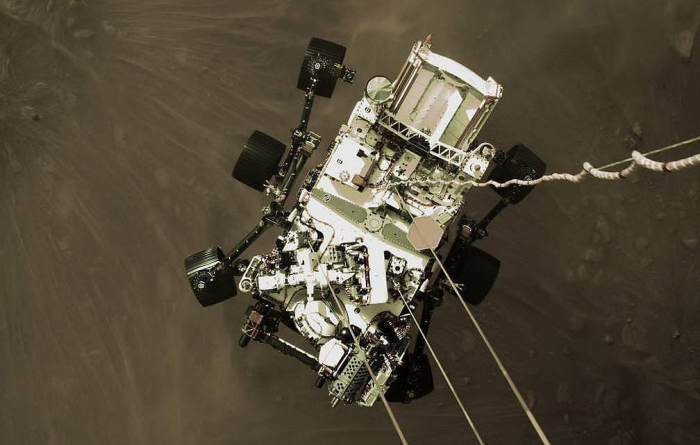NASA’s Mars Perseverance rover has went on its first drive across the planet’s surface after landing there in mid-February, the US-based National Aeronautics and Space Agency announced in a statement, TASS reports.
The Perseverance rover touched down the Red Planet’s surface in the area of Jezero Crater on February 18. All the operations were conducted in the automatic mode.
"NASA’s Mars 2020 Perseverance rover performed its first drive on Mars March 4, covering 21.3 feet (6.5 meters) across the Martian landscape," the statement from the agency stated. "The drive, which lasted about 33 minutes, propelled the rover forward 13 feet (4 meters), where it then turned in place 150 degrees to the left and backed up 8 feet (2.5 meters) into its new temporary parking space."
"The drive served as a mobility test that marks just one of many milestones as team members check out and calibrate every system, subsystem, and instrument on Perseverance," the statement continued. "Once the rover begins pursuing its science goals, regular commutes extending 656 feet (200 meters) or more are expected."
Commenting on the news, NASA’s senior technician in charge of Perseverance rover mission Anais Zarifian said: "When it comes to wheeled vehicles on other planets, there are few first-time events that measure up in significance to that of the first drive."
"This was our first chance to ‘kick the tires’ and take Perseverance out for a spin," Zarifian said. "The rover’s six-wheel drive responded superbly. We are now confident our drive system is good to go, capable of taking us wherever the science leads us over the next two years."
The agency also reported about the first checkout of the rover’s robotic arm operability. Robert Hogg, Mars 2020 Perseverance rover deputy mission manager, said: "Tuesday’s first test of the robotic arm was a big moment for us."
"That’s the main tool the science team will use to do close-up examination of the geologic features of Jezero Crater, and then we’ll drill and sample the ones they find the most interesting," Hogg said.
"When we got confirmation of the robotic arm flexing its muscles, including images of it working beautifully after its long trip to Mars - well, it made my day," he added.
An Atlas V launch vehicle with the rover blasted off from the spaceport at Cape Canaveral, Florida, in July 2020. The Perseverance is due to place rock and soil samples into about 40 special containers. NASA specialists expect to find the traces of ancient life on Mars with the rover’s assistance.
Another rover will retrieve these containers in 2026. The containers will be loaded into a special ascent vehicle that will deliver them to the Martian orbit. Another spacecraft will pick up the samples for their return to Earth. NASA expects this mission to take place in the 2030s.
More about: #NASA
















































